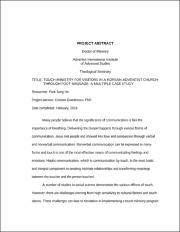| dc.description.abstract | Many people believe that the significance of communication is like the importance of breathing. Delivering the Gospel happens through various forms of communication. Jesus met people and showed His love and compassion through verbal and nonverbal communication. Nonverbal communication can be expressed in many forms and touch is one of the most effective means of communicating feelings and emotions. Haptic communication, which is communication by touch, is the most basic and integral component in creating intimate relationships and transferring meanings between the toucher and the person touched.
A number of studies in social science demonstrate the various effects of touch. However, there are challenges coming from high sensitivity to cultural factors and touch taboos. These challenges can lead to hesitation in implementing a touch ministry program
in a particular setting. Touch is not commonly used in the field of church mission. This qualitative multiple case study endeavored to analyze the meanings, challenges, and impact on decision making and behavior changes of the implementation of touch ministry through foot massage in Paju City Adventist Church in Korea. The participants were three visitors who started attending church worship as a result of the Foot Massage Touch Ministry (FMTM). Observation notes and semi-structured interviews for the participants, therapist, and foot massage assistant were used for data collection.
The major findings from this multi-case analysis revealed that FMTM, in a specially-designed church setting, with prayer, was effective and useful as an outreach church program. First, the findings of this study helped change the participants’ social and faith-based behaviors along with their perceptions of FMTM. Second, the findings improved the understanding of haptic communication between the toucher and the person touched. Third, this study also showed that the results of FMTM helped in emotional, mental, and physical healing. Finally, the results helped each participant build a relationship not only with the therapists but also with God, helping them to attend church and experience God’s love. The findings of this qualitative multiple case study were generally consistent with the existing studies relative to touch—mainly haptic communication and social behavior changes—and to the theoretical foundations of proxemics, social cognitive theory, and Simon’s model of decision process. The study concludes with the importance of touch ministry and recommendations for massage therapists and church leaders who desire to implement this outreach program. | en_US |

